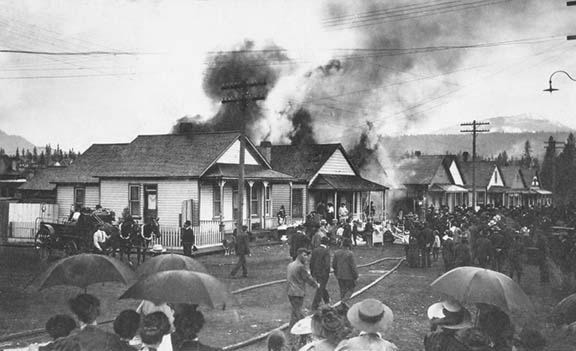Jim Cameron
The ladies of “The Lemon Patch” — one of many nicknames given to Cranbrook’s Red Light District — led lives in which violence, disease, addiction and early death, if not commonplace, certainly lurked nearby.
Living on the fringe of society in the heart of the city, they were both a part of the town’s everyday life and its seedy underbelly. The ladies have all since passed through the lace curtains of memory into the boudoirs of time but snippets of their lives remain.
Her name was Lillian Shotwell, sometimes Atwood, more recently, Brandt. No matter. She was commonly known as “Miss Lily”. On the morning of Tuesday, June 20, 1898, she died in Nellie McDowell’s house of prostitution in Cranbrook, becoming one-half of the first murder/suicide in the history of the city.
Miss Lily, formerly of Minneapolis, left the state when her husband was convicted of forgery and sentenced to prison. She travelled to Fernie to join former acquaintance Harry Brandt, a piano player in a bordello in that town. From there they made their way to Cranbrook, living as man and wife. Harry Brandt’s jealous streak caused the couple to quarrel and he left town for a few days, travelling to Nelson in an attempt to shake his despondency. The attempt failed.
On the morning of the day in question, Harry returned to Cranbrook to discover that Miss Lily, having sold their household goods, was living in Miss McDowell’s house. “Badly overcome,” he did what any man in his position would do. He went to Dickinson’s barbershop in the Cranbrook Hotel for a shave. He then went directly to the house where he was allowed to visit Miss Lily in the parlour in the company of Miss McDowell and Miss Salisbury, all of whom genially indulged in an early afternoon bottle of beer. For reasons unknown, Miss Lily asked for writing paper and the other two ladies left the room on the errand.
From the parlour suddenly came forth “the pleading cry for mercy, like the wail of a lost soul, three gunshots and silence.” The occupants of the house, rushing into the hall, watched in horror as the door to the parlour slowly opened. Brandt walked into the hall holding a revolver in his left hand. Miss McDowell cried, “Don’t shoot, Harry,” as the onlookers rushed to the rear of the building. Brandt glanced behind him, opened the front door and stepped onto the verandah. He emptied the spent casings and reloaded the revolver. Retracing his steps to the parlour he closed the door once again. A single shot was heard and then a deadly hush.
Coincidentally, Mr. C. Maggs and Mr. F.W. Hughes, proprietors of the B.C. Clothing House., were laying new carpets in another room of the house at the time. As something resembling luck would have it, they also served as the local undertakers. Mr. Maggs did what any undertaker would do under the circumstances; he rushed to the Herald newspaper office to return with Editor Simpson who duly recorded the scene in bloody detail for the next edition of the paper.
Miss Lily, with two bullets in her head, sat dying. Harry Brandt, with a single shot in the temple, lay likewise. Miss Lily soon expired. Dr. Green, Coroner Moffat and Constable Morris arrived shortly thereafter. Attempts to save Brandt proved futile and he died later that evening in the police station (a shack rented from Mr. Little — a proper jail having not yet been erected). Harry and Miss Lily were interred in the local cemetery (not the present day site but more probably the original cemetery somewhere near the Baker Home).
On a cheerier note: Miss Jennie Howard plied her wares in Cranbrook during the early years. “Jennie Hot Stuff” was a popular lady. The fact that she was a “woman of colour” may have contributed somewhat to her local fame, but in truth she was hailed as a fine pianist, singer and entertainer and was often hired to perform (legitimately) at local parties and formal occasions. Following the destruction by fire of her house on “The Row” she purchased property on the corner of Van Horne and 1st Street, now a small park with a fountain and a “Downtown Cranbrook Welcomes You” sign — where she ran a “boarding house” which, much later, became the Van Horne Apts. Jennie was eventually arrested and sentenced to a short time in the Nelson jail, travelling there by train under the watchful eye of aforementioned local Constable “Baldy” Morris. Jennie passed word that she and Baldy were leaving to be married and so saying, a group of town wags saw them off at the train station with a hail of rice and “Congratulations.”
When violence came to the women of the night, as it indubitably did, they were not always as unprepared as Miss Lily. In 1913, at West Port (the Ft. Steele waterfront on the opposite bank of the river from the present day Townsite) a madam by the name of Stella Duffield was accosted by William Drewlette, a bad man by all accounts. Drewlette journeyed from Cranbrook to Ft. Steele around midnight on a March evening in 1913, apparently to visit with his lover, one of the ladies of the house. During her subsequent hearing in front of Judge Thomson Miss Duffield claimed “he was bothering her” and fired the shots in an attempt to scare him. One of the bullets lodged in his groin. She was fined $200 and costs. The fate of Drewlette is unknown.
Next Week: The secret to a successful Red Light District: Location, location, location.
